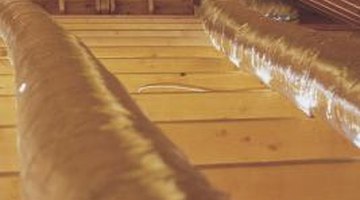Compare Metal Vs. Plastic AC Duct
The duct system, or ventilation system, of a building is essential to its comfort. Without it, the building cannot be properly heated or cooled. In some U.S. regions, a home may not require heating, but it may require cooling -- which is why the vast majority of houses have some form of ventilation system. However, there are many materials that can be used for the ductwork, including both plastic and metal. When choosing a material for replacement, or for repairing an existing system, it is important to note the differences and similarities between plastic and metal.
Metal AC Ducts

Metal ducts are found in the most common types of ventilation systems, and are made from sheet metal that has been bent into the desired shapes. The Environmental Protection Agency, or EPA, notes that today, many modern air duct systems are a mixture of both fiberglass and sheet metal, or of sheet metal and another type of plastic. This change in composition allows for better energy conservation, reduced condensation and better control in creating the desired temperature.
Plastic AC Ducts
Plastic air ducts are made from a variety of materials: PVC, polymer plastics and even fiberglass-reinforced plastic. No matter what type of plastic is used to create the ductwork, plastic air ducts work in the same manner as metal air ducts. However, instead of bending sheet metal to create the ducts, liquid plastic is poured into molds of various shapes and sizes. Furthermore, despite the manufacturer’s chosen composition, all plastic ductwork is made to withstand the hot and cold temperatures commonly found inside home heating and cooling systems.
Similarities
No matter what type of ductwork material is chosen, all ductwork will function in the same manner; it serves as a transportation system for heated or cooled air. The cooled (or heated) air is forced through the system and released through various openings throughout the building. Both types of ductwork can be insulated or non-insulated, often using additional plastic or fiberglass as an insulator. Furthermore, according to the Consumer Energy Center of the California Energy Commission, all ductwork, no matter what it is made of, has the potential to leak and those leaks can easily go unnoticed for years.
Differences
There are actually relatively few differences between the two types of air ducts, with the main difference being simply the materials being used. But according to the U.S. Department of Energy, metal ducts tend to be less efficient because the metal heats and cools in unconditioned areas of a house, such as the basement or attic. This results in air that needs to be reheated or re-cooled by the system. However, adding proper insulation can help remedy the situation.
References
Photo Credits
- Comstock/Comstock/Getty Images
More Articles



